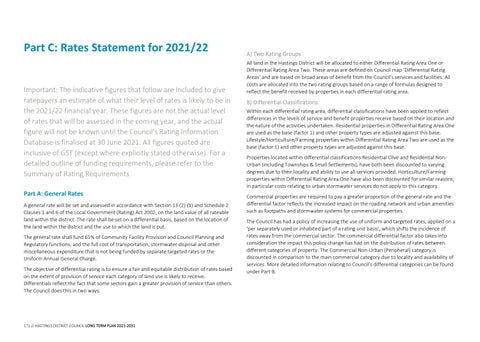Part C: Rates Statement for 2021/22
Important: The indicative figures that follow are included to give ratepayers an estimate of what their level of rates is likely to be in the 2021/22 financial year. These figures are not the actual level of rates that will be assessed in the coming year, and the actual figure will not be known until the Council’s Rating Information Database is finalised at 30 June 2021. All figures quoted are inclusive of GST (except where explicitly stated otherwise). For a detailed outline of funding requirements, please refer to the Summary of Rating Requirements Part A: General Rates A general rate will be set and assessed in accordance with Section 13 (2) (b) and Schedule 2 Clauses 1 and 6 of the Local Government (Rating) Act 2002, on the land value of all rateable land within the district. The rate shall be set on a differential basis, based on the location of the land within the district and the use to which the land is put. The general rate shall fund 65% of Community Facility Provision and Council Planning and Regulatory functions, and the full cost of transportation, stormwater disposal and other miscellaneous expenditure that is not being funded by separate targeted rates or the Uniform Annual General Charge. The objective of differential rating is to ensure a fair and equitable distribution of rates based on the extent of provision of service each category of land use is likely to receive. Differentials reflect the fact that some sectors gain a greater provision of service than others. The Council does this in two ways:
172 // HASTINGS DISTRICT COUNCIL LONG TERM PLAN 2021-2031
A) Two Rating Groups All land in the Hastings District will be allocated to either Differential Rating Area One or Differential Rating Area Two. These areas are defined on Council map ‘Differential Rating Areas’ and are based on broad areas of benefit from the Council’s services and facilities. All costs are allocated into the two rating groups based on a range of formulas designed to reflect the benefit received by properties in each differential rating area.
B) Differential Classifications Within each differential rating area, differential classifications have been applied to reflect differences in the levels of service and benefit properties receive based on their location and the nature of the activities undertaken. Residential properties in Differential Rating Area One are used as the base (factor 1) and other property types are adjusted against this base. Lifestyle/Horticulture/Farming properties within Differential Rating Area Two are used as the base (factor 1) and other property types are adjusted against this base. Properties located within differential classifications Residential Clive and Residential NonUrban (including Townships & Small Settlements), have both been discounted to varying degrees due to their locality and ability to use all services provided. Horticulture/Farming properties within Differential Rating Area One have also been discounted for similar reasons; in particular costs relating to urban stormwater services do not apply to this category. Commercial properties are required to pay a greater proportion of the general rate and the differential factor reflects the increased impact on the roading network and urban amenities such as footpaths and stormwater systems for commercial properties. The Council has had a policy of increasing the use of uniform and targeted rates, applied on a ‘per separately used or inhabited part of a rating unit basis’, which shifts the incidence of rates away from the commercial sector. The commercial differential factor also takes into consideration the impact this policy change has had on the distribution of rates between different categories of property. The Commercial Non-Urban (Peripheral) category is discounted in comparison to the main commercial category due to locality and availability of services. More detailed information relating to Council’s differential categories can be found under Part B.












